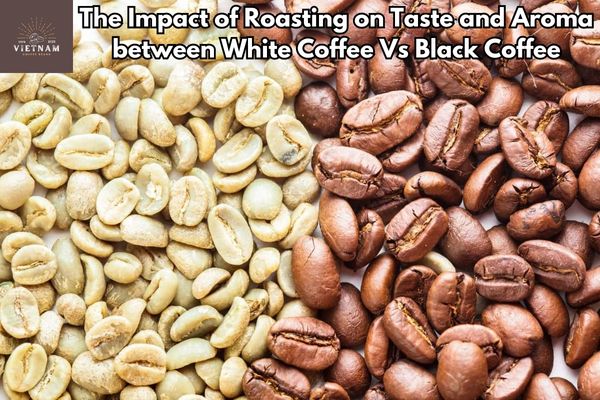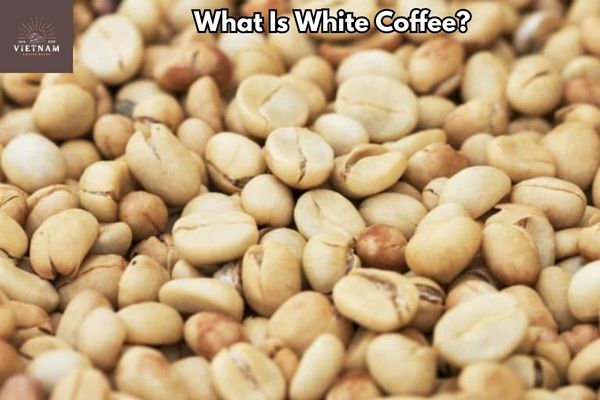White coffee and black coffee are two distinct beverages that offer unique flavors and characteristics. The difference between these coffees lies primarily in the roasting process, which influences taste, caffeine content, acidity, and aroma.
White coffee is roasted at lower temperatures, resulting in a sweeter and lighter taste. On the other hand, black coffee is roasted at higher temperatures, leading to a darker and more intense flavor.
This article aims to explore and compare the distinctive qualities of white and black coffee. It will shed light on their flavor profiles, roasting temperatures, caffeine content, acidity levels, and overall taste and aroma.
Key Takeaways Of White Coffee vs Black Coffee
- White coffee is roasted at a lower temperature for less time, resulting in a sweet and light taste.
- Black coffee is roasted at higher temperatures for longer, resulting in a darker and more intense flavor.
- White coffee beans are roasted at a cooler temperature of around 325ºF (160 ºC), while black coffee beans are usually roasted between 375ºF to 480ºF (190 ºC to 250 ºC).
- White coffee can have a higher caffeine content compared to black coffee, making it more suitable for a caffeine kick in the morning.
The Roasting Process: Light Vs Dark
The roasting process plays a significant role in determining the flavor profiles of white and black coffee. White coffee is roasted at a lower temperature, while black coffee is roasted at a higher temperature. The impact on coffee beans is profound, as the duration and temperature of the roasting process directly affect the chemical composition and flavor development.
The influence of roasting on flavor profiles is evident. White coffee boasts a sweet and light taste, while black coffee exhibits a darker and more intense flavor. The lower roasting temperature of white coffee preserves more of the bean’s natural flavors, resulting in a unique taste and aroma.
On the other hand, black coffee, with its higher roasting temperature, develops bolder and more complex flavors. The roasting process is a crucial step in creating the distinct characteristics of white and black coffee.
The roasting process is a key factor in determining the unique origins and characteristics of white coffee, as it delicately preserves the subtle flavors and natural sweetness, creating a distinct contrast to the bold and robust profile of dark roasted black coffee.
Understanding the Flavor Profiles

Acidity levels and roasting temperatures significantly influence the flavor profiles of different coffee varieties. When comparing the taste profiles of white and black coffee, it becomes clear that the roasting process plays a crucial role in determining the unique flavors of each.
White coffee, which is roasted at a lower temperature for less time, exhibits a light, sweet, fruity, and nutty taste. In contrast, black coffee, roasted at higher temperatures for longer durations, offers a darker and more intense flavor, often with hints of burnt charcoal and tobacco.
The table below provides a visual representation of the distinct flavor notes found in white and black coffee, further highlighting the differences between the two. Through exploring these flavor profiles, coffee enthusiasts can better understand and appreciate the nuances of each type.
| White Coffee | Black Coffee |
|---|---|
| Light | Dark |
| Sweet | Intense |
| Fruity | Charcoal |
Understanding the flavor profiles of white coffee versus black coffee goes beyond taste, as it also involves unveiling white coffee’s caffeine content, which is relatively higher due to its lighter roast, offering a unique and energizing experience for coffee enthusiasts.
Exploring Different Roasting Temperatures

Roasting temperatures play a significant role in determining the flavor profiles of different coffee varieties. The impact of roasting on coffee beans is an essential aspect of the art of coffee roasting. The temperature at which coffee beans are roasted can greatly affect the taste, aroma, and overall quality of the coffee. Here are some key points to consider:
Roasting temperatures can range from cooler temperatures of around 325ºF (160 ºC) for white coffee beans to higher temperatures of 375ºF to 480ºF (190 ºC to 250 ºC) for black coffee beans.
Lower roasting temperatures, as in white coffee, result in a lighter and sweeter taste, while higher temperatures, as in black coffee, produce a darker and more intense flavor.
The roasting temperature also affects the caffeine content, with white coffee beans potentially having higher levels compared to black coffee beans.
Acidity levels in coffee are influenced by the roasting temperature, with lighter roasts having higher acidity and contributing to fruity and sweet flavors.
Finally, the taste and aroma of coffee are heavily influenced by the roast level, with white coffee offering a light, sweet, fruity, and nutty taste, while black coffee provides a more typical dark coffee flavor.
Understanding the impact of roasting temperatures on coffee beans is crucial for appreciating the diverse flavors that different varieties can offer. The art of coffee roasting lies in finding the perfect balance of temperature to bring out the desired characteristics in each coffee bean.
Exploring different roasting temperatures of white coffee versus black coffee requires an understanding of the equipment needed for brewing white coffee, as its lighter roast demands precision and finesse to achieve the perfect extraction and unlock the delicate flavors that make it truly exceptional.
The Impact of Roasting on Taste and Aroma

Taste and aroma in coffee are influenced by the temperature at which the beans are roasted, with lighter roasts offering a sweeter and fruitier flavor profile. The impact of roasting techniques on the aroma of coffee is significant.
The temperature at which the beans are roasted affects the chemical reactions that occur during the process, leading to the development of different aromatic compounds. Lighter roasts retain more of the original flavors of the coffee beans, resulting in a more nuanced and delicate aroma.
On the other hand, darker roasts tend to have a more robust and intense aroma, with notes of chocolate or caramel.
The duration of the roasting process also plays a role in the development of aroma, with longer roasting times generally resulting in a stronger and more pronounced aroma.
Overall, the roasting technique employed greatly influences the aroma of coffee, contributing to the overall sensory experience of enjoying a cup of java.
The impact of roasting on the taste and aroma of white coffee versus black coffee is a fascinating journey that allows coffee lovers to truly experience the charm of Malaysian White Coffee, where the careful roasting process brings out the unique flavors and enticing aroma that make it a true delight for the senses.
Caffeine Content: White Coffee Vs Black Coffee
The difference in caffeine content between white and black coffee is a significant factor to consider when choosing which type of coffee to consume.
- White coffee beans can have a higher caffeine content compared to black coffee beans.
- White coffee is more suitable for a caffeine kick in the morning.
- Black coffee is often consumed in the afternoon or evening to avoid sleep disturbances.
- Some coffee enthusiasts claim that white coffee can have up to 50% more caffeine, but the actual difference is closer to 5%.
- Caffeine sensitivity should be considered when consuming white coffee.
Caffeine sensitivity varies among individuals, and some people may experience side effects such as jitters, increased heart rate, or difficulty sleeping if they consume high amounts of caffeine. Therefore, it is important to be mindful of one’s caffeine intake and adjust the type and timing of coffee consumption accordingly.
While white coffee may provide a stronger caffeine boost in the morning, black coffee is a better choice for those who are more sensitive to caffeine or prefer a milder effect later in the day.
When comparing the caffeine content of white coffee versus black coffee, it’s important to note that white coffee, particularly in the form of a white espresso, offers a lower caffeine kick, making it a suitable choice for those seeking a milder and more nuanced coffee experience.
Debunking the Myth: Caffeine Content Comparison
Debunking the myth of a significant difference in caffeine content between white and black coffee, recent studies have found that the actual variance is closer to 5% rather than the claimed 50%.
The caffeine content in different coffee beans is influenced by various factors, including the type of bean and the roasting process. Contrary to popular belief, the color of the coffee does not determine its caffeine content. Instead, the caffeine levels are primarily determined by the type and quality of the coffee beans used.
Additionally, the effect of roasting on caffeine levels is minimal. Roasting primarily affects the flavor and aroma profile of the coffee, while the caffeine content remains relatively stable.
Therefore, when choosing between white and black coffee based on caffeine content, it is important to consider personal preferences in taste and aroma rather than relying solely on the color of the coffee.
Debunking the myth surrounding the caffeine content comparison of white coffee versus black coffee, it’s crucial to understand that Dutch Bros White Coffee, with its unique blend and brewing technique, offers a distinct flavor profile that is not solely dependent on its caffeine content, allowing coffee enthusiasts to delve into a truly captivating and flavorful experience.
Acidity Levels: A Key Factor in Taste
Acidity levels play a significant role in determining the flavor profile of different coffee roasts. The importance of acidity in coffee cannot be understated as it contributes to the overall taste experience. The effect of roasting on acidity levels is crucial in understanding how different roasts can vary in flavor.
- Lighter roasts, such as white coffee, tend to have higher acidity levels.
- Acidity adds a bright and lively character to the coffee, enhancing its fruity and sweet flavors.
On the other hand, darker roasts, like black coffee, have lower acidity levels. The decrease in acidity in dark roasts results in a smoother and more mellow taste. The balance between acidity and other flavor components, like bitterness and sweetness, is essential in creating a well-rounded cup of coffee.
Understanding the influence of acidity and the effect of roasting on its levels allows coffee enthusiasts to appreciate the diverse range of flavors that different roasts offer.
When considering the acidity levels as a key factor in the taste of white coffee versus black coffee, embarking on a Penang White Coffee Latte flavor exploration unravels a harmonious blend of smoothness and subtle acidity, creating a delightful and well-balanced coffee experience for discerning palates.
The Role of Acidity in White Coffee and Black Coffee
One factor to consider when comparing white coffee and black coffee is the role of acidity in shaping their flavor profiles. The importance of acidity in coffee cannot be overlooked, as it contributes to the overall taste and complexity of the beverage.
The impact of roasting on acidity levels is significant, with lighter roasts, such as white coffee, having higher acidity compared to darker roasts like black coffee.
Acidity lends a bright and vibrant quality to coffee, adding a refreshing and tangy note to the flavor. It also enhances the fruity and sweet characteristics of white coffee, while darker roasts tend to have lower acidity, resulting in a bolder and more robust flavor profile.
The interplay between acidity and roasting levels is a crucial aspect to consider when appreciating the nuances of white coffee and black coffee.
When examining the role of acidity in white coffee and black coffee, it becomes evident that the acidity levels contribute to the overall flavor profile, highlighting the distinct characteristics of each brew; for a truly invigorating experience, coffee enthusiasts should not miss the opportunity to try the new white coffee at Dutch Bros, where the carefully balanced acidity adds a delightful twist to the taste.
Unveiling the Unique Taste of White Coffee
Unveiling the unique taste of white coffee and black coffee brings forth a remarkable journey of flavors, where the nuances of each brew captivate the senses; for those seeking to elevate their coffee experience, it’s worth exploring the top white coffee recipes to discover new dimensions of indulgence and richness.
Revealing the distinct characteristics of the lesser-known brew known as white coffee, its flavor profile offers a delicate balance of sweetness and lightness. The brewing methods of white coffee and black coffee differ significantly, resulting in unique taste experiences.
White coffee is roasted at a lower temperature for a shorter duration, while black coffee is roasted at higher temperatures for longer. This variance in roasting methods gives white coffee its lighter and sweeter taste, whereas black coffee has a darker and more intense flavor.
When it comes to pairing flavors, white coffee complements desserts exceptionally well. Its fruity and nutty taste enhances the sweetness of desserts, creating a harmonious combination.
Whether enjoyed alone or paired with a delectable treat, white coffee offers a unique and enjoyable coffee experience.
Appreciating the Bold Flavors of Black Coffee
Appreciating the robust and intense taste of black coffee involves understanding the differences in roasting methods compared to its lighter counterpart.
Black coffee, often referred to as a journey into darkness, offers a unique and bold flavor profile that captivates coffee enthusiasts.
The art of brewing the perfect cup of black coffee lies in mastering the techniques required to bring out its rich and complex flavors.
The beans are roasted at higher temperatures for a longer duration, resulting in a deep, smoky, and sometimes even bitter taste.
The darkness of the roast brings out the natural oils and flavors within the coffee beans, creating a beverage that is both powerful and invigorating.
Exploring the bold flavors of black coffee is an adventure that requires an appreciation for its intense characteristics and a willingness to embrace the darker side of coffee.
Frequently Asked Questions
Conclusion
In conclusion, the distinction between white coffee and black coffee lies in the roasting process, resulting in variations in flavor, caffeine content, acidity, and aroma.
White coffee, with its lighter roast, offers a sweet and light taste, while black coffee, with its darker roast, provides a more intense flavor.
White coffee is gaining popularity for its unique profile, while black coffee remains a favorite for its bold flavors.
In the intriguing world of coffee, the comparison between White Coffee and Black Coffee reveals distinct taste experiences. White Coffee is made with milk or cream, often leading to a smooth and mild taste, while Black Coffee is brewed without these additives, highlighting the beans’ natural flavors and aromas.
The addition of dairy in White Coffee creates a softer flavor profile, contrasting with Black Coffee, which offers a robust and unaltered experience. Whether paired with sweet pastries or savored on its own, the choice between White Coffee and Black Coffee reflects personal preferences and cultural influences, making the exploration of these unique flavors a delightful journey for coffee enthusiasts.
Understanding these differences allows coffee enthusiasts to appreciate and enjoy the diverse range of flavors that both white and black coffee have to offer.






